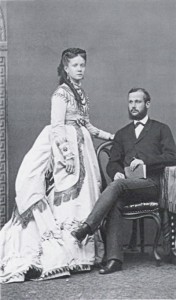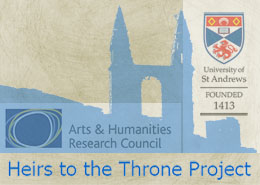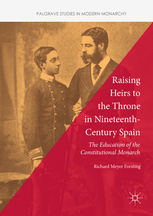A Prince educated in Exile 
Carmina López Sanchez
On 30 September 1868, Isabel II, la de los tristes destinos (she of the sad destinies), as the novelist Galdós called her, left Spain in the wake of the so-called Glorious Revolution. She reached the train station in Biarritz accompanied by her family: her husband, Francisco de Asís, and her children, Alfonso, Prince of Asturias, and the Princesses Pilar (1861-1878), Paz (1862-1946), and Eulalia (1864-1958), as well as Carlos Marfori, her confessor, Father Claret, and Sor Patrocinio. Emperor Napoleon III welcomed the royal party directly at the station. The family first took up residence at Pau Palace, close to the Spanish border, before deciding to move on to Paris. In March 1869, the Queen bought the Basilewsky Palace (which was immediately renamed Castilla). For his part, Francisco de Asís experienced this exile like a liberation from court life and from his marriage; he settled independently in Épinay-sur-Seine, in the outskirts of the French capital.
The Queen’s eldest daughter Isabel, known widely as la Chata – affectionately referring to her cute snub nose – was not in Spain during the revolution. She had married Count Cayetano de Borbón-Dos Sicilias of Girgenti in spring 1868 and happened to be in Paris on her honeymoon. When he heard about the revolution, the Count of Girgenti left for Madrid to take command of his regiment of hussars, eventually fighting at the battle of Alcolea.
Princess Isabel, born in 1851, held the title of Princess of Asturias until the birth of her brother Alfonso, since, traditionally, it was the male heir to the throne, upon whom the title of Prince of Asturias was conferred. Any daughters, even if they were first-born, were simply addressed as “Infantas” (princesses). The title “Princess of Asturias” could only be granted by the King. Article 201 of the Spanish Constitution of 1812 states: The first-born son of the King will be called the Prince of Asturias. This designation would be confirmed again in the 1869 Constitution (Article 79): When the King dies, the new King will swear to observe and enforce the Constitution and the laws in the same way and on the same terms that the court declared the first King should follow the Constitution. The Prince of Asturias will swear the same oath when he turns eighteen years old.
The later Spanish constitutions of the 19th century do not explicitly mention the “Prince of Asturias” but refer to the “successor”, “first-born”, or “heir”. However, on 30 May 1850, under the reign of Isabel II, a Royal Decree appeared in the Gaceta. Its single paragraph stated: the immediate successors to the Crown, according to the Constitution of the Monarchy, without distinguishing between males or females, will continue to be called the Prince of Asturias, with all the honors and prerogatives that come with such a high position. This Royal Decree made Isabel de Borbón y Borbón the Princess of Asturias from her birth in 1851 until her brother Alfonso was born six years later. Isabel was re-titled the Princess of Spain, but upon her family’s restoration to the Spanish throne she would once again become Princess of Asturias – until the birth of Maria de las Mercedes, King Alfonso’s first-born daughter.
Although the Royal Decree of 1850 allowed women to be Princesses of Asturias, there is no doubt that all Spaniards wished for a male heir to be born. On 29 November 1857 the newspapers reported that at a quarter to eleven at night twenty-five cannons and tolling of bells announced to this capital that the queen had given birth to a prince. The next day the Gaceta de Madrid officially announced the birth. The prince was baptized on 7 December; his godparents were his sister Isabel and Pope Pío IX, who was represented by the nuncio monsignor Berili. Alfonso would receive his first communion from that same Pope years later, on 8 March 1870, at Saint Peter’s Basilica.
The birth of Alfonso XII filled the royal family with happiness. It is important to remember that in the 19th century Spain went through three civil wars, the so-called “Carlistas Wars” that were originally caused by dynastic motives. The birth of a male heir granted the Spanish throne safety from the immediate danger caused by Carlista pretenders. Without a doubt, the child Alfonso was a great hope for Spaniards, but no one knew yet how short and intense the life of this recently-born Prince of Asturias would be.
The Prince spent his first years in the Royal Palace in Madrid, in a very tense political atmosphere amid schemes plotted by people as loyal as his own father or his uncle, the Duke of Montpensier. Despite this atmosphere of continual intrigue, the prince was carefully educated to prepare him for his future as king of Spain. The Marques of Alcañices was appointed head of the court the Prince of Asturias. In 1865, when Alfonso turned seven, the Marques was succeeded by the Archbishop of Burgos, Fernando de la Puente y Primo de Rivera (1808-1867). The boy prince was frequently ill, so physical exercise was a very important part of his education. Francisco de Aguilera, Count of Villalobos, was personally responsible for Prince Alfonso’s physical exercise and a formal regimen started in 1863. In these early years we already find William Morphy at Alfonso’s side as one of the prince’s chamberlains. Morphy accompanied the Prince to the Theresianum grammar school in Vienna and remained his personal secretary until his death.
From the very beginning, Prince Alfonso accompanied his parents on a series of royal visits that took the family all over Spain. The visits had a clear propagandistic intention. Alfonso often wore the regional costumes of the places he visited, much the same as his sister, Isabel, who was one year older. On a trip to Asturias, the Prince was introduced to the Virgin of Covadonga, and it was there that he was given the name Pelayo: A symbolic name that referred to the initiator of the Reconquista, the historical process during which the Christians conquered the territory under Muslim rule in the Iberian Peninsula between 722 and 1492. These visits sought to strengthen the image of the Spanish monarchy, and there is no doubt that the tender image of the prince and princess dressed in the traditional regional costumes contributed significantly to popularise the royal family.
When the royal family was forced into exile in 1868, Alfonso was eleven years old. The exile enabled the young prince to experience other European countries, see different systems of government, and learn new languages; Alfonso spoke French fluently, also German and a bit of English. When he arrived in Paris, the Prince’s education had to continue, and the Stanislas School in the 6th arrondissement was selected for him. He took up his studies in this private catholic institute in February 1869. In addition to his classes at Stanislas the Prince had private lessons in international politics with the Count of Benalúa, nephew of the Duke of Sesto. While in exile the young prince continued his education, the “Alfonsian circle” began to develop in Spain. The majority of Spaniards, who supported the restoration of the Bourbon dynasty, were aware that Isabel II could not return to Spain to rule as queen; instead, her son Alfonso was supposed to be King.
On 25 June 1870, Isabel II decided to abdicate. Thus, the twelve-year old Alfonso became the bearer of all historical rights of the House of Bourbon in Spain. From the very beginning of her exile, many advisors had suggested that the Queen abdicate in favour of her son, but Isabel wanted to avoid a regency for her under-age son at all cost. In June 1870 she eventually yielded to pressure from Napoleon III, to whom she had promised in 1869 that she would abdicate at an opportune moment. This moment had arrived when, after the Constitutional Courts declared that Spain would remain a monarchy, Leopoldo de Hohenzollern-Sigmaringen was presented as a candidate for the Spanish throne. This candidacy not only provoked the Queen’s abdication; it also made the consequences of the 1868 revolution visible on an international scale. The Franco-Prussian war erupted in July of 1870 over the question of the Spanish succession.
During the war, in October 1870, the Spanish royal family had to move from Paris to Geneva. From May 1870, Thomas O’Ryan (1821-1902) was responsible for directing the prince’s education; the prince studied Latin, Greek, French, Geography, History and Mathematics with Professor Víctor Duret; he also attended a physical education class and continued his exercise regimen. In autumn 1871, O’Ryan looked for an adequate school for the exiled heir to the Spanish crown. Finally, the Theresianum in Vienna was chosen, and he matriculated there at the beginning of 1872. Alfonso was accompanied to Austria by O’Ryan, who was soon replaced by William Morphy, who assumed responsibility for the prince’s education. Morphy, along with the Duke of Sesto, José Osorio y Silva-Bazán, son of the Marquis of Alcañices, and the assistance of the valet Ceferino Rodríguez, would remain with the prince until the end of his life.
Meanwhile in Spain, various people were entrusted with the task of laying down the foundations for the restoration of the Bourbon monarchy: the Count of Cheste, Eusebio Calonge, Francisco Lersundi, Montpensier himself after the Treaty of Cannes, and lastly Cánovas del Castillo, who was overall in charge of the process that would lead to the restoration of the Bourbon under Alfonso XII in 1873.
The great change in public opinion in favor of the prince started with the Alfonsian Liberal Circle. The Alfonsians were even able to gain control of a few newspapers, such as La Época, El Tiempo, La Política, or El Eco de Galicia. Cánovas del Castillo’s goal was to present the Spaniards with a more mature image of the young prince, suggesting that he was capable of becoming the King of Spain. For this reason Cánovas recommended that Alfonso matriculate at the Military Academy of Sandhurst, where he could acquire a good military education. From the beginning, Cánovas hoped to create the image of a “king-soldier,” which he believed to be an absolute necessity for the King of Spain – because of the many revolts of the 19th century.
Accompanied by Colonel Juan de Velasco Alfonso arrived at Sandhurst on 5 October 1874. On 28 November Alfonso received many well-wishes for his birthday. In order to make the most of the opportunity, Cánovas del Castillo sent a thank-you card to all well-wishers. This letter ended up becoming known as the famous “Sandhurst Manifesto”. The manifesto contained a pithy statement: “I will neither stop being a good Spaniard, nor, like all of my ancestors, a good Catholic, nor, as a man of this century truly liberal.” In his book Cánovas, Benito Pérez Galdós captured this apparent contradiction of being both Catholic and liberal in a dialogue at the end of the book’s first chapter: Liberal and Catholic? But the Pope has said that Liberalism is sin! Unless Prince Alfonso has discovered the secret of inserting the soul of Pío IX into the body of Espartero…
The Manifesto was published in Spain on 26 December 1874. The pronunciamiento of General Martínez Campos took place three days later. This military revolt precipitated the return of Alfonso XII to Spain. Having stayed in Paris with his family for Christmas, the new king entered Spain via the city of Barcelona on 9 January 1875. When he arrived in Madrid five days later he was received with huge enthusiasm. At that moment, a new life began for the man that was now King Alfonso XII, who would be known as “The Pacifier.”
Further Reading:
La Parra López, Emilio (coord.), La imagen del poder. Reyes y regentes en la España del siglo XIX, Madrid, Síntesis, 2011.
Burdiel, Isabel, Isabel II. Una biografía (1830-1904), Madrid, Taurus, 2010.
Escudero, José Antonio, El Rey, Historia de la Monarquía, vol. 1, Barcelona, Planeta Historia y Sociedad, 2008.
Seco Serrano, Carlos, Alfonso XII, Barcelona, Ariel, 2007.
Rubio, María José, La Chata. La infanta Isabel de Borbón y la Corona de España, Madrid, La esfera de los libros, 2003.
Dardé Moreno, Carlos, Alfonso XII, Madrid, Arlanza Ediciones, 2001.
Espadas Burgos, Alfonso XII y los orígenes de la Restauración, Madrid, Consejo Superior de Investigaciones Científicas, 1990.
Lema, Salvador Bermúdez de Castro y O’Lawlor, Marqués de (1863-1945), De la Revolución a la Restauración, vol. I y II, Madrid, Voluntad, 1927.
Memorias del conde de Benalua-duque de San Pedro Galatino, tomo I, Blass, 1924.
The Sandhurst Manifesto, in: La América, 28 December 1874, p. 3 (printed version).
The Archive of the Real Academia de la Historia (Royal Academy of History) is useful for research on the correspondence of Isabel II. The archive can be accessed online http://www.rah.es/biblioteca.htm










